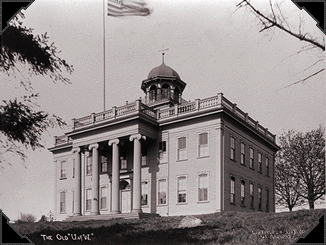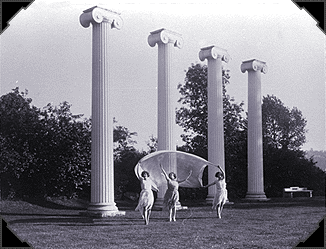Placement of UW columns was a winning idea

This photo of the original Territorial University building (now the site of the Olympic Hotel in downtown Seattle) shows the columns as they looked when constructed in 1861.
While Columns magazine is 90 years old, the age of the original columns in the University’s Sylvan Theater beats the magazine by another 47 years. These are the original, hard-carved pillars which once graced the main portico of the University’s first building dating from 1861—although the present Ionic capitals atop the four columns are modern fiberglass replacements, modeled from the originals.
Professor Edmond S. Meany made an eloquent plea to save the original building previous to its demolition in 1908, even suggesting that students and alumni of the University join together and physically carry the building from its downtown site to the campus in Montlake. Even though the building was in remarkably good condition, it was razed and only the four columns made their way to campus.
In 1911 the columns were initially erected in the area now know as the “Quad.” But after the Collegiate Gothic buildings began to encircle the Greek Revival columns, campus administrators realized there was a clash of styles. Carl F. Gould, then head of the architecture department and unofficial campus architect, saw the columns as an opportunity for his students to participate in a real design problem. During Winter Quarter 1920, he organized a competition for the relocation and reuse of the columns. Sophomore Marshall W. Gill, son of Seattle Mayor Hiram Gill, won the First Mention prize for his design solution—incorporating the columns into a Sylvan Theater.

The four columns saved from the original university building in a 1920 photograph. Photo courtesy Special Collections.
In late 1920, site work began on the theater by the university’s buildings and grounds department, with help from several student organizations. The next spring, under the watchful eyes of an alumni committee from the Class of 1911, the site received the columns as the architectural focus of the new, open-air theater.
For Gill, his first architectural project would also be his last. He died unexpectedly in June of that year from a blood clot in the brain. He had completed only his junior year. But Gill was not forgotten. His former classmates helped raise funds for a memorial to honor his life and his talent, and Gould himself designed the gift. This memorial was the first of many cast-store benches that now grace the campus. Gill’s memorial bench, placed in 1923, fittingly resides to the west of the columns in the theatrical setting he designed.